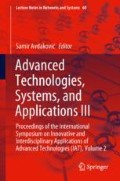Abstract
The finite element method (FEM) is a numerical method used for solving different problems in engineering field. The starting point being a continuum media of the structure, meaning that the structure is undamaged. However, in order to be able to represent the actual stated of the structure, with all of its defects and cracks, it is necessary to incorporate these anomalies. This all with the aim that the model is a good representative of the real structure. This paper gives and overview of several numerical approached in the modelling of discontinuities on the masonry structures.
Access this chapter
Tax calculation will be finalised at checkout
Purchases are for personal use only
References
Burland, J.B., Broms, B.B., de Mello, V.F.B.: Behavior of foundations and structures, state‐of‐the‐art report. In: 9th International Conference on Soil Mechanics and Foundation Engineering II, Tokyo, Japan (1977)
Sarhosis, V., Oliveira, D.V., Lourenco, P.B.: On the mechanical behavior of masonry. In: Sarhosis, V., Bagi, K., Lemos, J.V., Milani, G. (eds.) Computational Modeling of Masonry Structures Using the Discrete Element Method, pp. 1–27. IGI Global (2016)
Lemos, J.V.: Modeling stone masonry dynamics with 3DEC. In: Konietzky, H. (ed.) Modeling Stone Masonry Dynamics with 3DEC, pp. 7–12. Taylor & Francis Group, London (2004)
Roca, P., Cervera, M., Gariup, G., Pela’, L.: Structural analysis of masonry historical constructions. Classical and advanced approaches. Arch. Comput. Methods Eng. 17, 299–325 (2010)
Lourenco, P.B.: Computations on historic masonry structures. Prog. Struct. Eng. Mater. 4(3), 301–319 (2002)
Cundall, P.A.: A computer model for simulating progressive, large-scale movements in blocky rock systems. In: Proceedings of the International Symposium on Rock Fracture, Nancy, October 1971, vol. 1, paper no. II–8, pp. 129–136. International Society for Rock Mechanics (ISRM) (1971)
Cundall, P., Hart, D.: Numerical modelling of discontinua. J. Eng. Comput. 9, 101–113 (1992)
Lemos, J.V.: Assessment of the ultimate load of a masonry arch using discrete elements. In: Middleton, J., Pande, G.N. (eds.) 1995 3rd International Symposium on Computer Methods in Structural Masonry, Lisbon, Portugal, pp. 294–302. Books and Journals International, Swansea (1996)
Tóth, A.R., Orbán, Z., Bagi, K.: Discrete element analysis of a stone masonry arch. Mech. Res. Commun. 36, 469–480 (2009)
Kassotakis, N., Sarhosis, V., Forgács, T., Bagi, K.: Discrete element modelling of multi-ring brickwork masonry arches. In: 13th Canadian Masonry Symposium, pp. 1–11. Canada Masonry Design Centre, Halifax (2017)
Lemos, J.V.: Discrete element modelling of the seismic behaviour of stone masonry arches. In: Pande, G.N., Middleton, J., Kralj, B. (eds.) Computer Methods in Structural Masonry – 4, pp. 220–227. E&FN Spon, London (1998). Proceedings of the 4th International Symposium Numerical Methods Structural Masonry, STRUMAS IV, Florence, September 1997
DeLorenzis, L., DeJong, M.J., Ochsendorf, J.: Failure of masonry arches under impulse base motion. Earthq. Eng. Struct. Dynam. 36(14), 2119–2136 (2007)
ITASCA: 3DEC - Universal Distinct Element Code Manual. Theory and Background. Itasca Consulting Group, Minneapolis (2004)
Cundall, P.A.: Formulation of a three-dimensional distinct element model. Part I: a scheme to detect and represent contacts in a system composed of many polyhedral blocks. Int. J. Rock Mech. 25, 107–116 (1988)
Giordano, A., Mele, E., De Luca, A.: Modelling of historical masonry structures: comparison of different approaches through a case study. Eng. Struct. 24, 1057–1069 (2002)
Alexandris, A., Protopapa, E., Psycharis, I.: Collapse mechanisms of masonry buildings derived by the distinct element method. In: Proceedings of the 13th World Conference on Earthquake Engineering, paper no. 548 (2004)
Sarhosis, V., Oliveira, D.V., Lemos, J.V., Lourenco, P.B.: The effect of skew angle on the mechanical behaviour of masonry arches. Mech. Res. Commun. 61, 53–59 (2014)
Sarhosis, V., Sheng, Y.: Identification of material parameters for low bond strength masonry. Eng. Struct. 60, 100–110 (2014)
Shi, G.-H., Goodman, R.E.: Discontinuous deformation analysis. In: Proceedings of 25th U.S. Symposium Rock Mechanics, pp. 269–271. SME/AIME, Evanston (1984)
Shi, G.H.: Discontinuous deformation analysis: a new numerical model for the statics and dynamics of block system. Ph.D. thesis. Department of Civil Engineering, University of California, Berkeley, CA (1988)
Lin, C.T., Amadei, B., Jung, J., Dwyer, J.: Extensions of discontinuous deformation analysis for jointed rock masses. Int. J. Rock Mech. Min. Sci. Geomech. Abstr. 33(7), 671–694 (1996)
Ma, M.Y., Pan, A.D., Luan, M., Gebara, J.M.: Stone arch bridge analysis by the DDA method. In: Arch Bridges, pp. 247–256. Thomas Telford, London (1995)
https://commons.wikimedia.org/wiki/File:Ponte_Mosca_Torino.JPG
Ma, M.Y., Pan, A.D., Luan, M., Gebara, J.M.: Seismic analysis of stone arch bridges using discontinuous deformation analysis. In: 11th World Conference on Earthquake Engineering, paper no. 1551, pp. 1–8 (1995)
Thavalingam, A., Bićanić, N., Robinson, J.I., Ponniah, D.A.: Computational framework for discontinuous modelling of masonry arch bridges. Comput. Struct. 79(19), 1821–1830 (2001)
Bićanić, N., Stirling, C., Pearce, C.J.: Discontinuous modelling of masonry bridges. Comput. Mech. 31, 60–68 (2003)
Jean, M., Moreau, J.J.: Dynamics of elastic or rigid bodies with frictional contact and numerical methods. In: Blanc, R., Suquet, P., Raous, M. (eds.) Proceedings of the Mecanique, Modelalisation Numerique et Dynamique des Materiaux, pp. 9–29. Publications du LMA, Marseille (1991)
Allix, O., Daudeville, L., Ladevèze, P.: Proceedings of MECAMAT: Mechanics and Mechanisms of Damage in Composites and Multi-Materials, Saint-Etienne, 15–17 November 1989, p. 143 (1989). Baptiste, D. (ed.)
Chetouane, B., Dubois, F., Vinches, M., Bohatier, C.: NSCD discrete element method for modelling masonry structures. Int. J. Numer. Methods Eng. 64, 65–94 (2005)
Acary, V., Jean, M.: Numerical simulation of monuments by the contact dynamics method. In: Workshop on Seismic Performance of Monuments, DGEMN-LNEC-JRC, Monument 1998, Lisbon, Portugal, November 1998, pp. 69–78 (1998)
Author information
Authors and Affiliations
Corresponding author
Editor information
Editors and Affiliations
Rights and permissions
Copyright information
© 2019 Springer Nature Switzerland AG
About this paper
Cite this paper
Ademovic, N., Hadzima-Nyarko, M. (2019). Different Possibilities for Modelling Cracked Masonry Structures. In: Avdaković, S. (eds) Advanced Technologies, Systems, and Applications III. IAT 2018. Lecture Notes in Networks and Systems, vol 60. Springer, Cham. https://doi.org/10.1007/978-3-030-02577-9_13
Download citation
DOI: https://doi.org/10.1007/978-3-030-02577-9_13
Published:
Publisher Name: Springer, Cham
Print ISBN: 978-3-030-02576-2
Online ISBN: 978-3-030-02577-9
eBook Packages: Intelligent Technologies and RoboticsIntelligent Technologies and Robotics (R0)

